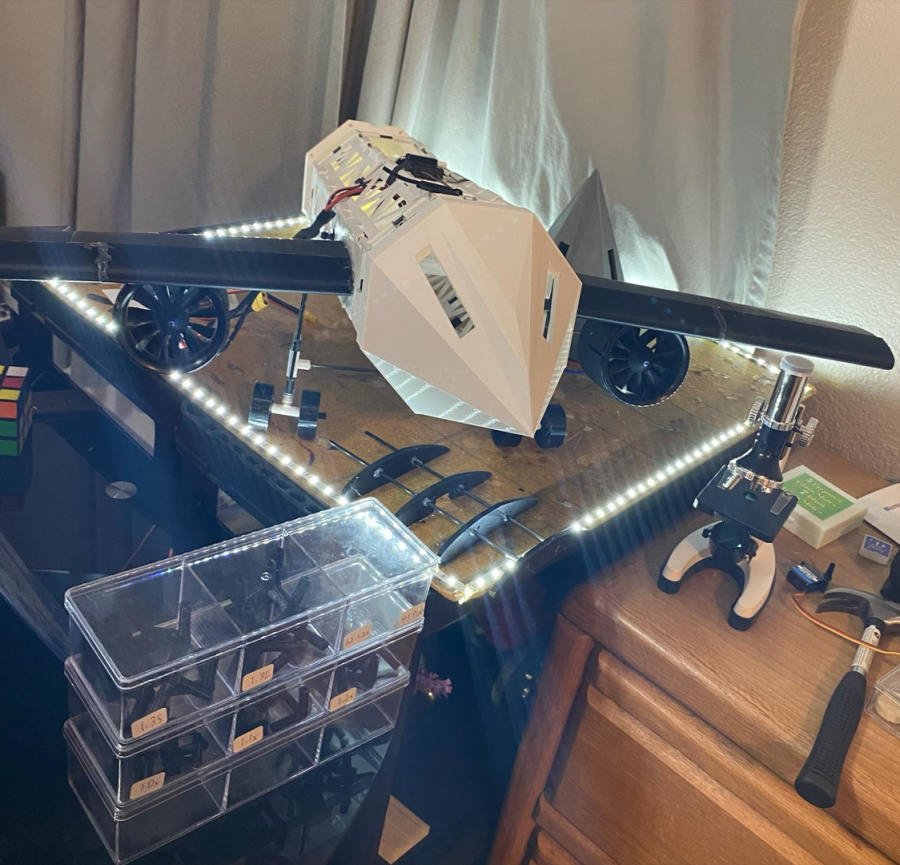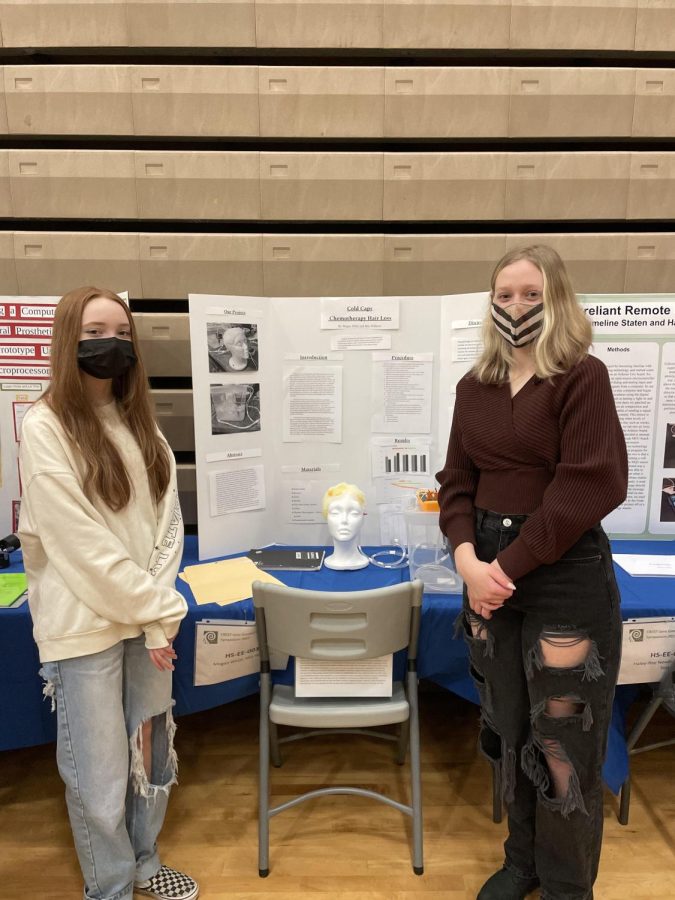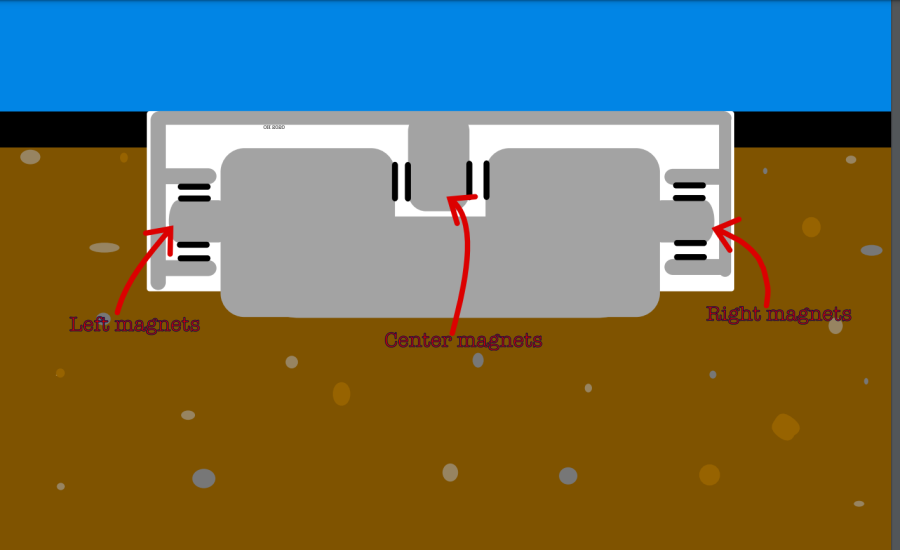Inventing season
February 13, 2023
Research is integral to improving our knowledge of our world, and it’s not limited to adult scientists in labs. Some Wilsonville HS students spend their free time inventing therapy caps, building model planes, and more!
Our inventors also present their research at our school district’s science fair, and compete for a chance to compete at the state and international levels, earning merit and cash prizes along the way. Read about your students, your peers, and your friends – and the amazing things that they have invented to potentially change the world!
Adventures with aerodynamics
A semi-completed modular aircraft – a snapshot of Jesse’s third- and fourth-year ISEF projects. He is excited for the fair this year!
Some students who walk through the hallways of Wilsonville High School are inventors– both as a hobby and as a means to better society as a whole.
Jesse Hayworth, a senior, has worked on aviation-based projects for many years, but from a different perspective. He was inspired by a YouTube documentary on ground effect vehicles during freshman year, and thought, “Why don’t I try, right? Just put some foam board together; get a basic fan set up and see if I can get something that can fly.”
So, freshman year he built a ground effect vehicle, which is “like a hovercraft.” He used foam to build the model plane, and got mentorship from ISEF advisors and Robotics mentors, especially when it came to electrical skills. He ended with a model which flew at 10 to 15 miles per hour at 0.5 meters off the ground, and the model itself was 1.25 meters long and 1 meter in length.
The following year, he built a jet engine. His goal was “to make a jet engine for as cheap as [he] possibly could,” and managed to get the cost down to about 300 dollars. He learned to weld materials together from a kit to make this jet engine.
During Hayworth’s junior year, he wanted to make pieces (like LEGOs) which could “be fit together to construct vehicles.” Using carbon fiber rods and custom 3D printed parts which fit around the rods, he formed vehicle frames. This year, he’s continuing the project “to allow for modular aircraft that includes modular flaps, those kinds of things,” which will help build “pretty cheap and printable aircraft” in the future.
Speaking of the future, Hayworth definitely wants to join the aviation and aerospace industry, and is thankful for the technical support he has gotten through the ISEF and Robotics programs at WVHS.
Junior Paul Liu also has a knack for aerodynamic inventions. This year, he’s working on a “noise and drag reduction system on the side mirror for cars” with his sophomore teammate Ronak Sameer-Asita.
Liu explained that his invention works best for driving in straight lines. “For example,” he commented, “on the highway… the car will have a system on the mirror cap which will open up and allow more airflow to go through the system,” therefore reducing turbulence. This mechanical addition to a car mirror will also reduce wind noise.
Liu’s inspiration for the drag reduction system was watching F1. He said F1 cars “have a drag reduction system, but on the rear of the car on the wing. And this has never been done on a normal car.” Normal cars don’t have wings, so Liu and Sameer-Asita considered other parts of cars which connected the air a lot: the mirrors were completely exposed and produced a lot of drag.
Liu mentioned that they are “currently building and testing right now.” Based on their design, they hope to “improve miles per gallon by at least one percent.”
This school prepares students to make changes in the world in the future– but know that, with the great resources our school provides, students can make a change right now.
Cold Caps and screen protectors
Photo provided by Mia Williams
Megan Whitt and Mia Williams stand in front of their science fair display, ready to present! The science fair is a great place for students to share their ideas and inventions.
Inventions are fun hobbies driven by students’ passions to create something– which could maybe change the world. A few students at Wilsonville HS were interviewed on their past projects.
Last year, as freshmen, current sophomores Megan Whitt and Mia Willams invented a Cold Cap. Mia explained that their device was “a cost-efficient Cold Cap for people who experience hair loss.”
Their inspiration to prevent hair loss after chemotherapy was, as Whitt put it, “hair loss is something that can affect somebody quite a bit.” In the past, the two had “studied the effects of ice and its benefits on the brain.”
Whitt described that Cold Caps are an existing technology, and the device “shoots cold liquid through the cap to keep the hair cool.” However, their cost ranges from $4,000 to $10,000 on the market. “For somebody who goes through chemotherapy on its own that’s expensive, especially with people who don’t have health care,” she said.
Whitt and Williams imagined an effective Cold Cap which costs less than $60, and set out to invent one.
Their prototype involved a fishbowl system, some ice water, and a tubing system. Williams explained that the fishbowl system was used to “run the water through a tubing.” They used “silicone to form a cap” and switched out the different fabrics to test which worked the best. The ice water would “run through a little tubing system connected to the silicone cap.”
One may ask, how do Cold Caps work to reduce hair loss? Whitt explained that the cold “makes the blood vessels in the skin of the head narrower,” which reduces the amount of chemo which reaches hair follicles. Both Whitt and Williams believe strongly that losing one’s hair is losing “a part of one’s identity.”
To Whitt, combatting effects of cancer and chemotherapy were also based on her family members’ experiences as “cancer patients,” and they had “experienced hair loss.” She’s done “quite a bit of research on the effects of hair loss on people.” In the future, she wants to continue into the medical field, because she’s “really passionate about womens’ health care.” She aims to enter the fields of gynecology and obstetrics.
Williams is “interested in the psychological range of people, especially severe cases,” and is considering entering the field of psychology in the future.
Last year, another project tackled the question of improving health, but from a different perspective.
Juniors Paul Liu and Kate Kurata worked on inventing a “red light therapy screen protector” last year. The screen protector “improves eyesight overtime,” said Liu.
He explained that many existing screen protectors “decrease the damage from blue light” by filtering it. However, their invention– a screen protector– “reduced all the blue and white lights, which are the lights which damage eyesight,” and “added red light. Most of the blue and white light were eliminated, and 80% of red light went through.”
Their final prototype “didn’t produce results as high” as they wanted, but it “achieved most of [their] goal: The red light definitely increased overall in the blue light and white light decreased.”
Liu would like to enter the field of aerospace engineering in the future, in part inspired by his engineering experiences on this project. Kurata plans to study neurology or chemistry, getting a masters or a PhD in the subject.
Taking flight
The proposal to implement Hill’s Maglev-based invention. Embedding it in the runway so the platform is level with the ground makes it easier for the plane to mount.
Planes are great; their emissions, not so much. Some students have dedicated days, or even years, to combatting this situation.
Oaklyn Hill, senior, filed a provisional patent their freshman year on a project they’d been thinking of since late elementary school. “I started learning about how absolutely garbage travel is for the planet, and so I’ve been trying to find a way to make air travel less harmful,” says Hill. They travel a lot with their family, so they’ve seen the negative contributions of air travel firsthand.
Hill’s invention involves using Maglev (magnetic levitation) technologies for launching planes. “Maglev can get to the necessary speed to launch a commercial Boeing 747,” adds Hill. By using Maglev technologies, sustainability is increased when commercial planes take off.
In the future, Hill is “definitely going towards climate geared innovation, especially in traveling globalization.” Since they are “big on cross disciplinary stuff,” they know “just looking at electromagnetic stuff isn’t going to fix all the world’s problems.” Hill hasn’t not decided which specific topic they want to pursue in higher education.
On the other hand, some students are just beginning their inventing journey!
Aarush Palve, freshman, is currently working on a “small-scale plasma/ionic thruster that works by increasing the intensity of microwave radiation to ionize air molecules and then vectoring them away from the apparatus to generate thrust.”
His inspiration was to solve the issue of the “emissions generated by the aircraft industry. Since ionic emissions are generated by the aircraft industry.” On a large scale, Palve is particularly interested in combatting “rising global temperatures and the overall effects of global warming,” which stem from these emissions.
Palve plans to “find a job that makes a ‘bunch of money’” to fuel his dreams. He plans to pursue an education in STEM, and considers ISEF the best place to test his interests. “I also just like making things,” he added.
As students continue to pursue their passions, they know that the sky is… well, even the sky isn’t really a limit.


